
Current electricity, Electrostatics and capacitor revision questions and answers ( A-level physics paper 2 section C)

1. (a) State Coulomb’s law of electrostatics (01marks)
Coulomb’s law states that the force between two point charges is directly proportional to the product of the magnitude of the charges and inversely proportional to the square of the distance between the charges.
(b) (i) Describe how a conductor may be positively charge but remains at zero potential(03marks)
A negatively charged rod is brought near a neutral sphere. Distribution of charges occurs. The sphere is then earthed in the presence of the rod. Electrons flow to the earth. The sphere is positively charged and at zero potential. When the rod is remove the sphere remain positively charged.

(ii) Explain how the presence of a neutral conductor near a charged conducting sphere may reduce the potential of the sphere.
When a positively charged insulated sphere A is placed close to a neutral insulted sphere B, negative charges are attracted to side close to A while positive charges are repelled to the far end. Potential at ab; V= Va + Vb + Vc. Since Vb and Vc are of opposite sign and c is further from A, the negative charges at b effectively reduce the potential at a.
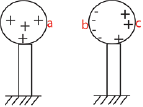
(c) In the figure below, points P and Q are at a distances 30.0cm and 20.0cm from a point charge of 4.0μC respectively.

Calculate
(i) Electric potential difference between P and Q (05marks)
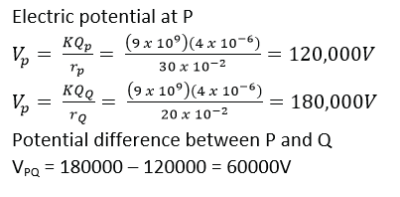
(ii) Energy required to bring a charge of +1.0μC from infinity to Q. (03marks)
Energy, E = QV
= 1 x 10-6 x 180000 = 0.18J
(d) Describe with the aid of a diagram an experiment to show that excess charge resides only on outside of hollow conductor.
Experiment to show that excess charge resides only on the outside of a hollow conductor.
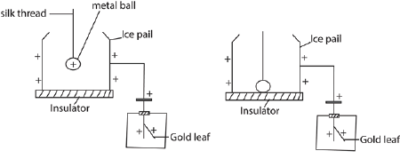
- Ice pail is placed on an insulator and connected to a gold leaf electroscope
- A positively charged metal ball held on a long silk thread is lowered into the pail without touching the sided nor the bottom.
- Positive charges are induced on the outside of the pail and golf leaf diverges. The divergence does not change when the ball is moved about as long as it does not touch the pail.
- When the metal ball is allowed to touch the bottom, the divergence remains unchanged although it loses the charge.
- This shows that the charge induced inside the ice pail (hollow conductor) is of equal magnitude and opposite to the charge on the metal ball. Thus the total charge inside the hollow conductor is zero.
- Hence excess charge resides only on the outside of a hollow conductor.
2. (a)(i) Define e.m.f of a battery. (01marks)
The voltage or electric potential difference across the terminals of a cell when no current is drawn from it.
Or
It is the p.d across the terminals of the battery on an open circuit.
(ii) Explain why e.m.f of a battery left standing in a room for long decreases. (02marks)
Moisture in the room contains ions which allow electric conductions between the terminals of the battery and therefore the e.m.f of the battery reduces.
(b) The figure below shows a network resistors connected to show identical cells of e.m.f 1.5V and internal resistance 0.8Ω.

Calculate the current supplied by the cells (04marks)
From E = I(R+r)
The effective e.m.f of cells in parallel = e.m.f of one cell = 1.5V

I = 0.789A
The current flowing is 0.789A
(c) Describe an experiment which can be carried out to determine the resistance of a wire using a potentiometer. (06marks)
An experiment to determine resistance of a wire using a potentiometer

- The balance length L1 from A is recorded
- A is disconnected from C0 and galvanometer is disconnected from C1
- A is connected to C1 and galvanometer to C2
- The balance length L2 from A is recorded.

(d) The figure below shows a uniform resistance wire AB, 100cm long and resistance 4.0Ω connected with a 2.0Ω resistor through switch K2. When K1 is closed and K2 open, the balance length is 53cm.
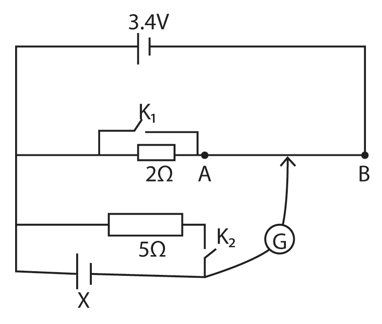
Find the
(i) Balance length when K1 and K2 are both open (04marks)
LAB = 100cm, RAB = 4Ω, Ed = 3.4V, r = 0Ω, LAJ = 53cm
Considering upper circuit
Ed = Id (R + r)
3.4 = Id(4 + 2 + 0)
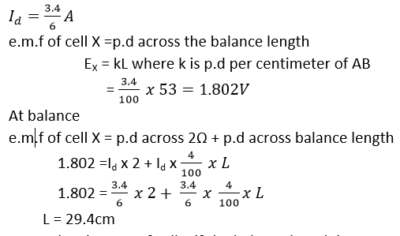
(ii) Internal resistance of cell X if the balance length is 44.1cm when both K1 and K2 are closed (01marks)
LAJ = 44.1cm
LAJ = 44.1cm
Using upper circuit
Ed = Id(R+r)
3.4 = Id(4 + 0)
Id = 0.85

3. (a)(i) Define farad. (01mark)
A faraday is the capacitance of a capacitor when a charge stored is 1C and potential difference is 1V.
(ii) Describe briefly the energy transformations that take place when charging a capacitor using a dry cell. (02marks)
Chemical energy in the cell → electrical energy → electrostatic potential energy when the charge is being stored on the capacitor plates + heat
(b)(i) What is meant by dielectric constant? (02marks)
Dielectric constant is the ratio of capacitance of a capacitor with a medium between its plates to the capacitance of the same capacitor with a vacuum between its plates.
Or
Dielectric constant is the ratio of permittivity of a medium to permittivity of space.
(ii) A parallel plane capacitor is connected to 100V and then isolated. When a sheet of a dielectric is inserted between the plates, the p.d. decreased to 30V. Calculate the dielectric constant of the dielectric. (03marks)
Let the capacitance of a capacitor be C
Charge stored, Q = CV
= C x 100 = 100C
When a material is inserted between the plates of the capacitor
Q = C’V’
= ErCx 30
By conservation of charge
100C = ErCx 30
E_r= 100/30=3.33
(c) A 60 μF is charged from a 120V supply. It is then connected across the terminals of a 20μF capacitor. Calculate the
(i) final p.d. across the combination (03marks)
Total charge = total charge after combination;
When the capacitor are joined, the p.d, V, across is the same
C1V1 = C1V + C2V = (C1 + C2)V
60 x 10-6 x 120 = (20 x 10-6 +20 x 10-6)V = 80 x 10-6V
V = 90V
The final p.d = 90V
(ii) Difference in the initial and final energies stored in the capacitor and comment on the difference. (05marks)

Comment: Energy after is less because some energy is lost as heat in the connecting wires
(d) Explain the principles of operation of a lightning conductor. (05marks)
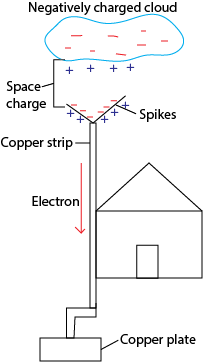
Action
(i) When a negatively charged cloud passes over lightning conductor, it induces positive charges on the spikes by repelling electrons to the grounds through copper conductor.
(ii) A high electric field concentration of positive ions on the spikes ionizes air around it causing positively charged ions and negatively ions.
(iii) The negatively charged ions are attracted and discharged at the spikes while the positively charged ions are repelled to form a space charges which neutralizes the negative charge on the cloud. In this way the harmful effect of the cloud is reduced.
4. (a) Define the following as applied to a battery:
(i) Electromotive force
The voltage or electric potential difference across the terminals of a cell when no current is drawn from it.
Or
It is the ratio of the power the source generated to the current it delivers
(ii) Internal resistance
This is the opposition to the flow of current with the battery due to its chemical composition.
(b) A battery of e.m.f E and internal resistance, r, is connected across a load of resistance, R. Derive an expression for maximum power delivered to the load. (04marks)
Power delivered to the load, P = I2R

(c) Determined how resistance of a resistor may be determined using a slide wire potentiometer (05marks)

(d) Explain why the potentiometer is more suitable for measuring small resistance than Wheatstone bridge (02marks)
At balance point the current in a potentiometer wires is zero thus the resistance of the connecting wires does not affect the reading
(e) In the figure below, AB is a uniform resistance wire of resistance 2.0Ω, and length 100cm, E is a cell of e.m.f 1.5V and D is a driver cell of negligible internal resistance. When switch K is closed the balance length AC is 82.5cm.
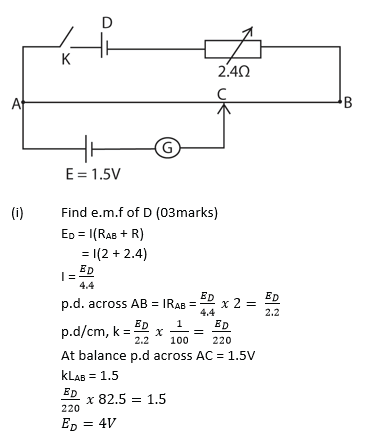
(ii) If E and the galvanometer are replaced by a voltmeter of resistance 20.0Ω, find the reading of the voltmeter when contact C is placed at the mid-point of AB and the value of R is 1.0Ω.
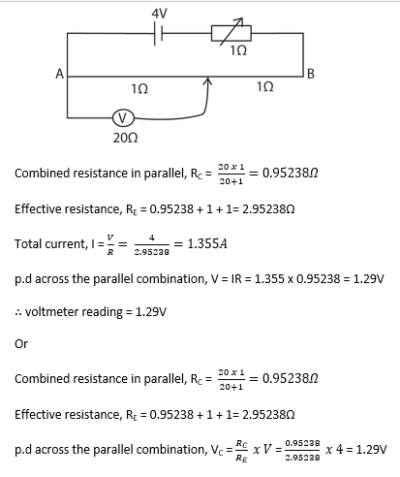
5. (a) (i) Define electric field intensity and potential difference. (02marks)
Electric field intensity at a point is the force exerted on positive charge of 1C placed a point in an electric field.
The potential difference between two points is the work done to move 1C of positive charge from one point to another in electric field.
(ii) Derive an expression for electric potential difference between two points a and b in the field of a single point charge +Q (04marks)

(b) Describe an experiment to show that when two dissimilar dielectrics are rubbed together, they acquire equal but opposite charge.
- Wool is wrapped round on end of a polythene rod and several turns of thread wound over wool. The loose end of the thread is pulled so that the wool rubs the polythene making sure that the hands do not touch the wool.
- The end of the rod with wool is inserted in the metal can place on neutral electroscope. No divergence is observed.
- When the polythene is carefully pulled out to leave the wool, a divergence of the leaf of electroscope is observed.
- The wool is then withdrawn and the electroscope discharged, when the rod is placed inside the can, the electroscope is observed to diverge to the same extent as before.
- Therefore two dissimilar dielectric have acquired equal but opposite charges.
(c) Two point charges of +5μF and -3μF are placed at points A and B as shown in the figure below.
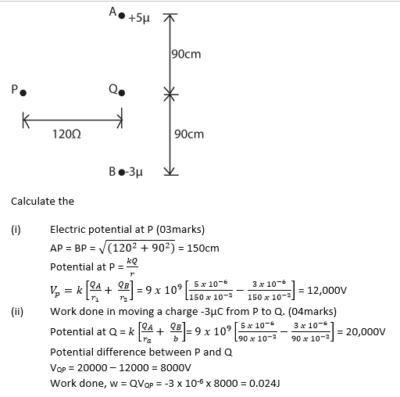
(d) State any two characteristics of an equipotential (02marks)
The work done to move a charge along the surface is zero
The field line are perpendicular to the surface.
6. (a) Define the following
(i) Capacitance (01mark)
It is the ratio of the magnitude of a charge on either plates of a capacitor to the potential difference between the plates.
Or
It is the magnitudes of charge on a conductor to potential of the conductor.
(ii) Relative permittivity (01mark)
It is the ration of the permittivity of a material to permittivity of free space.
(b) Two capacitors of capacitances C1 and C2 are connected in series with a battery of e.m.f V as shown below.
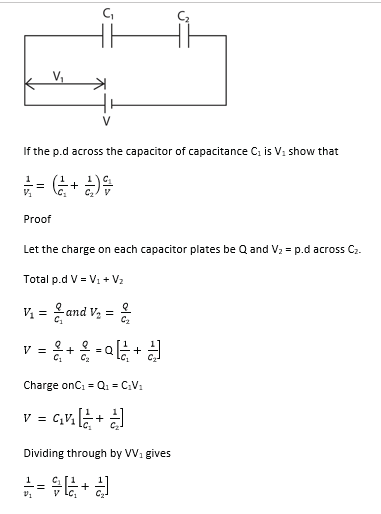
(c) Describe an experiment to determine the capacitance of a capacitor using a vibrating reed circuit.
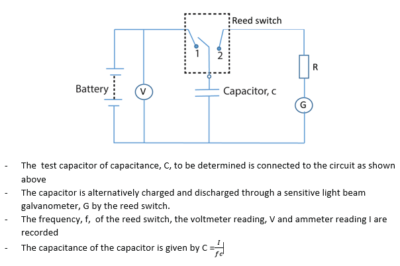
(d) A battery of e.m.f120V is connected to a network of capacitors as shown in the figure below

(e) Describe how the effect of a dielectric medium on the capacitance of a capacitor may be determined. (03marks)

7. (a)(i) State the law of conservation of current at a junction in an electric circuit. (01marks)
Law of conservation of current at a point/junction states that the total current flowing through a junction is equal to the total current flowing out of a junction.
(ii) Explain why current from a battery is greater when bulbs are connected in parallel than when they are in series across a battery. (03marks)
The effective resistance across the bulbs is smaller when the bulbs are in parallel than when they are in series. Since the current is a ratio of p.d to resistance the current is higher when the bulbs are connected in parallel than when connected in series.
(b) A conductor of length L and cross sectional area A has n free electrons per unit volume. The average drift velocity of the electrons is v and each electron carries charge e.
Derive an expression for the current which flows (03marks)

(c) A battery with an e.m.f of 12V and internal resistance 2Ω is connected to a wire of resistance 10Ω.
(i) Calculate the p.d across the wire. (02marks)

(ii) What is the p.d across the wire become if a 15Ω resistor is connected parallel to it? (03marks)

(d)(i) Define electrical resistivity and state its units (02marks)
Electrical resistivity of a material is the resistance is the resistance across 1m cube of the material
Units is Ohm-meter (Ωm)
(ii) Describe an experiment to determine the resistivity of the material of a wire using an ammeter, meter rule and voltmeter

8. (a) (i) Define temperature coefficient of resistance and state its units. (02marks)
The temperature coefficient of resistance is the fractional change in resistance at 00C for very degree Celsius rise in temperature.
Units is K-1
(ii)Explain why temperature coefficient of resistance is positive for metals. (03marks)
The resistance of a metal increases with increase in temperature because when the temperature increases, the atoms of the metal vibrate with higher amplitude reducing the mean free path for conduction of electrons.
The charge flow per second (or current) is reduced. This implies that resistance has increased. Hence fractional change in temperature is positive.
(b) (i) Derive the conditions for balance of meter bridge. (05marks)

(ii) Explain why the meter bridge is unsuitable for comparison of low resistances. (02marks)
When the resistances are very low, the resistance of the connecting wire or the resistance of end error become significant.
(c) A standard resistor is connected across the right hand gap of a meter bridge and a coil X across the left hand gap of meter bridge. When the coil is heated to a temperature of 400C, the balance length is 525mm from left-hand end of the bridge.
When the temperature of X is raised to 1000C, the balance point is 546mm from the left end.
(i) Calculate the temperature coefficient of resistance of the coil X (06marks)
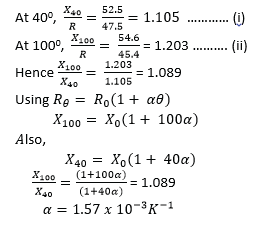
(ii) Why are standard resistors made of alloys such as constantan and magnesium? (02marks)
The temperature coefficient of constantan and magnesium are small, thus, there negligible change in resistance with moderate change temperature
9. (a) Derive an expression for energy stored in a capacitor of capacitance, C, charged to voltage, V. (04marks)

(b) A parallel plate capacitor with plate area of 2 x 10-2m2 and plate separation of 5.0x 10-3m is connected to a 500V supply.
(i) Calculate the energy stored in the capacitor (04marks)

(ii) If the space between the plates is completely filled with oil and the total charge in the capacitor becomes 4.42 x 10-8C. Find the dielectric constant of the oil (03marks)
Capacitance, C’ = εrC, where εr = electric field

(c) Explain how a lightning conductor may protect a building from damage by lightning. (05marks)

Action
(i) When a negatively charged cloud passes over lightning conductor, it induces positive charges on the spikes by repelling electrons to the grounds through copper conductor.
(ii) A high electric field concentration of positive ions on the spikes ionizes air around it causing positively charged ions and negatively ions.
(iii) The negatively charged ions are attracted and discharged at the spikes while the positively charged ions are repelled to form a space charges which neutralizes the negative charge on the cloud. In this way the harmful effect of the cloud is reduced.
(d) Describe an experiment to show that charge on a hollow conductor resides on the outer surface. (04marks)
Experiment to show that excess charge resides only on the outside of a hollow conductor.

- Ice pail is placed on an insulator and connected to a gold leaf electroscope
- A positively charged metal ball held on a long silk thread is lowered into the pail without touching the sided nor the bottom.
- Positive charges are induced on the outside of the pail and golf leaf diverges. The divergence does not change when the ball is moved about as long as it does not touch the pail.
- When the metal ball is allowed to touch the bottom, the divergence remains unchanged although it loses the charge.
- This shows that the charge induced inside the ice pail (hollow conductor) is of equal magnitude and opposite to the charge on the metal ball. Thus the total charge inside the hollow conductor is zero.
- Hence excess charge resides only on the outside of a hollow conductor.
10. (a)(i) Define electrical resistivity. (01mark)
Electric resistivity is the resistance across opposite faces of 1m cube of material.
(ii) Explain how length and temperature of a conductor affect its resistance. (04marks)
Length:- Increase in length leads to longer path of electrons. This means more collision will occur with the metal ions. This leads to a reduction in current and hence increase in resistance.
Temperature:- increase in temperature increases the amplitude of vibrations of ions. This increases the rate of collision between the electrons and the ions. This will reduce the amount of current flowing and hence increase in resistance.
The figure below shows a circuit-voltage graphs for a metallic wire at two different temperatures T1 and T2.

State in which of the two temperatures is resistance greater and explain your answer (03marks)
T2>T1
At T1 the gradient is higher than at T2 (or at each voltage the current flowing at temperature T1 is higher than at temperature T2). This implies that the resistance at T1 is lower than the resistance at T2.
(b) (i) Derive the balance condition when using a meter bridge to measure resistance. (03marks)

(ii) State two precautions taken to achieve an accurate measurement. (02marks)
- The slide wire should have uniform resistance
- The resistors should be chosen such the balance point is approximately in the middle of slide wire.
- The resistors should be interchanged to use average values.
(c) The figure below shows two resistors P and Q of resistance 5Ω and 2Ω respectively connected in the two gaps of the meter bridge.

A resistor X of cross-sectional area 1mm2 is connected across P so that the balance point is 66.7cm from A. if the resistivity of wire X is 1.0 x 10-5Ωm and the resistance wire AB of the meter bridge is 100cm long, calculate the length of X. (04marks)

(d) Explain how electrons attain a steady drift velocity when current flows through a conductor. (02marks).
When a p.d is supplied across a conductor, the free electrons are accelerated in the direction of the field. As they move, they collide with the metal ions until they attain a steady drift velocity.
11. (a) (i) Explain equipotential surface. (04marks)
Equipotential surface is one on which the electric potential is the same (or constant) at all points. The work done to move a charge from one point to another along the surface is zero. This implies that the electric field is perpendicular to the surface.
(ii) Give an example of an equipotential surface (01mark)
- the surface of the earth
- the surface of charged conductor.
- An imaginary surface containing points equidistant from a point charge
(b) (i) State coulomb’s law. (01 marks)
Coulomb’s law states that the force between two point charges is directly proportional to the product of the magnitude of charges and inversely proportional to the square of the distance between them.
(ii) With the aid of a diagram, explain the variation of electric potential with distance from the center of charged metal sphere (03marks)
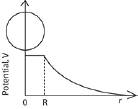
Within the sphere, electric potential is constant. There is no charge inside.
Outside the sphere, the potential is inversely proportional to the distance r from the center of the sphere
(iii) Two metal plates A and B, 30cm apart are connected to a 5kVdic supply as shown in the figure below.

When a small charged sphere, s, of mass 9.0 x 10-3kg is placed the plates, it remains stationary. Indicate the forces acting on the sphere and determine the magnitude of the charge on the sphere. (04marks)

(c) (i) Define electric field intensity. (01marks)
Electric field intensity at a point is the force exerted on positive charge of 1C placed a point in an electric field.
(ii) With the aid of a diagram, explain electrostatic shielding. (04marks)

- The test material is suspended in an almost enclosed conducting can.
- It includes an equal and opposite charge inside the can and similar charge to it on the outer wall such that the net charge inside the can is zero.
- An external field only affects charge distribution on the outer surface of the can.
- Hence the material is shielded from the external field.
NB: Electrostatic shielding is the act of protecting material from the influence of an electric field or creating an electrically neutral space in an electric field.
(d) Explain briefly why a neutral metal body is attracted to a charged body when brought near it. (02marks)
- When a neutral metal is brought near a charged material, opposite charge is induced the side of the metal and the charge similar to that of the charged body on the far side.
- Since opposite charges are now closer to each other, the attraction force between the material is greater that the repulsion force. Hence the metal body is attracted.
12. (a) (i) What is meant by capacitance of a capacitor? (01mark)
Capacitance of a capacitor is the ratio of the magnitude of charge on either plates of a capacitor to the capacitor to the potential difference between the plates
(ii) A parallel plate capacitor is connected across a battery and charged fully. When a dielectric material is now inserted between its plates, the amount of charge stored in the capacitor changes. Explain the change. (04marks)
- When a dielectric is inserted between the plates of a charged capacitor, its molecules get polarized. The surfaces of the dielectric thus develops charges opposite to those on adjacent capacitor plates.
- Electric field intensity develops between the faces of the dielectric in the opposition of the applied field and this reduces the electric field between the plates.
- Since the p.d is now less than the terminal p.d of the battery, more charges are conducted to the capacitor until the p.d is again equal to that of the battery. Hence charge on the capacitor increase.
.
(iii) Describe an experiment to determine the relative permittivity of a dielectric. (04marks)
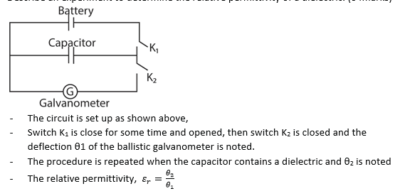
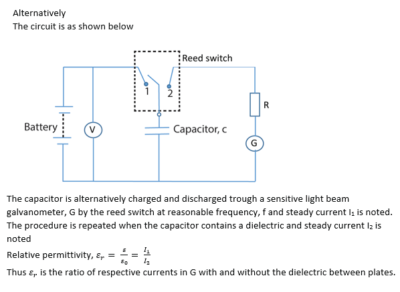
(b) A network of capacitors of capacitances 40μF, 50μF and 70μF is connected to a battery of 9V as shown in the figure below

(c) Explain corona discharge
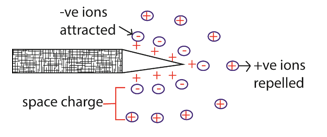
- On a pointed charged conductor, there is high charge density and thus high electric field at the sharp point.
- This causes air molecules around the sharp point to ionize and form positive and negative ions.
- The similar charges to those on the conductor are repelled while those opposite are attracted to neutralize some of the charges on the conductor.
- The apparent loss of charge from the conductor in this way is called Corona discharge.
13. (a)(i) Define temperature coefficient of resistance (01mark)
Temperature coefficient of resistance is the fractional change in resistance at 00C for every degree Celsius rise in temperature.
(ii) Explain the origin of the heating effect of electric current in metal conductor. (03marks)
During the flow of current, electrons moving through the metal conductor may collide with the positive ions in the metallic lattice. On collision, the kinetic energy possesses by electron is transferred into heat.
(iii) Describe with the aid of an I-V sketch the variation of current with p.d across a semiconductor diode. (02marks)
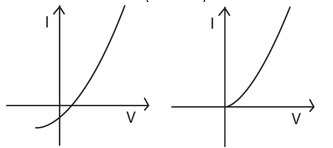
When the diode is forward biased, the current increases rapidly as the p.d is increased. When the reversed biased little or no current flows
(b) A cell, a bulb, a switch and a thermistor with negative temperature coefficient of resistance are connected as shown in the figures (i) and (ii) below

(i) Explain what would happen when in figure (i) switch K is closed (04marks)
At room temperature, the resistance of thermistor is high, current flowing is thus small and bulb lights dimly. As current flows, the thermistor heats up (temperature increases) and the resistance decreases leading to increase in current and brightness of the bulb.
(ii) If the bulb in figure (i) is removed and the circuit connected as shown in figure (ii), explain what would happen when switch K is closed (03marks)
On closing K, the thermistor heats up and its resistance reduces. The reduction in resistance causes high current through the cell. High current in the cell and due to internal resistance, overheating occurs destroying the cell
(c) State the law of conservation of current at the junction (01mark)
The law of conservation of current at a junction states that the algebraic sum of current at the junction is zero
(d) Two cells A of e.m.f 6V and internal resistance 2Ω and B of e.m.f3V and internal resistance 1Ω respectively are connected across a uniform resistance wire Cd of resistance 8Ω as shown in the figure below
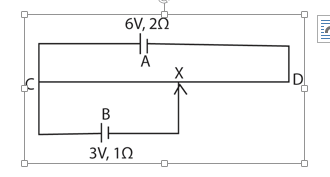
If X is exactly in the middle of the wire CD, Calculate the
Power dissipated in CX.(04marks)

I3 = I1 + I2 …………………………………… (i)
Consider loop 1
3 = I2 + 4I3 ………………………………….. (ii)
Consider loop 2
6 = 2I1 + 4I3 + 4I1
6 = 6I1 + 4I3…………………………. (iii)
Eqn. (ii) and eqn. (i)
3 = I2 + 4(I1+I2)
= 5I2 + 4I1 …………………………………. (iv)
Eqn. (iii) and eqn. (i)
6 = 6I1 + 4(I1 + I2)
= 10I1 + 4I2
3 = 5I1 + 2I2………………………… (v)
Eqn. (v) x 5 – eqn. (iv) x 2
9 = 17I1
I1 = 0.55A

14. (a)(i) Define capacitance of a capacitor (01mark)
Capacitance of a capacitor is the ratio of the magnitude of charge on either plate of the capacitor to the potential difference across the plates.
(ii) Describe briefly an experiment to show the effect of placing a sheet of glass or mica between the plates of a capacitor on capacitance. (05marks)
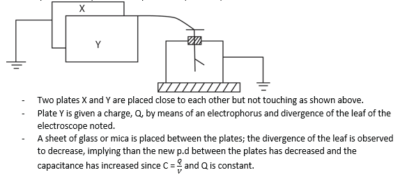
(b) Describe how the unknown capacitance of a capacitor can be determined using a ballistic galvanometer. (04marks)
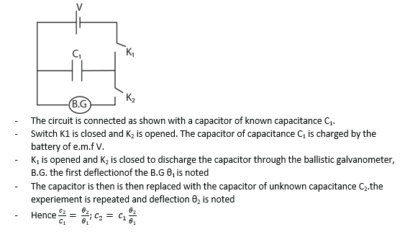
(c) Explain briefly how a charged capacitor can be fully discharged. (02marks)

The wire is connected from the positive plate to the negative plate. Electrons flow from the negative plate to the positive plate neutralizing the positive charges. The follow of electrons continues until all the capacitor is fully neutralized.
(d) A 3μF capacitor is connected in series with a 6μF capacitor. The combination is then connected in parallel with 1μF capacitor to 12V battery as shown in the figure below

15. (a) (i) Define the following; electric field intensity and electric potential at a point (02marks)
Electric field intensity at a point is the force exerted on positive charge of 1C placed a point in an electric field.
Electric potential is the work done in bringing 1C of positive charge from infinity to appoint against an electric field.
Show that the electric field intensity at a point is equal to the negative potential gradient at that point. (04marks)
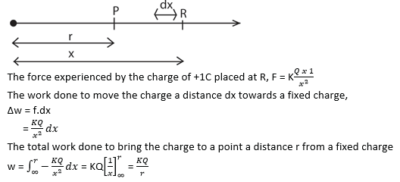
(b) (i) Explain with the aid of a diagram, how an insulated metal sphere can be charged by induction using a negatively charged rod. (03marks)
Two insulated metal spheres A and B, arranged such that they touch one another.
A negatively charged rod C is brought near A.

When the spheres are separated while C in position, A will be positively charged while B will be negatively charged.
(ii) Describe how a gold leaf electroscope can be used to detect the presence of a charge on the body
- A gold leaf electroscope is first charged positively or negatively by bring either a negatively or positively charged rod close to the cap and the then earthed by touching.
- When a body with similar charge as that on the gold leaf electroscope is brought close to the cap the leaf diverges more.
(c) (i) Write down the equation for the electrostatic force between two isolated point charges in a vacuum. (01mark)

(ii) Sketch the electric field lines between two negatively charged spheres carrying unequal charges and use the sketches to explain a neutral point. (02marks)

A neutral point in an electric field is a point where the resultant electric field intensity is zero.
(d) A charged polystyrene sphere of mass 2g is suspended by affine nylon thread between two plates 5cm apart as shown in the figure below
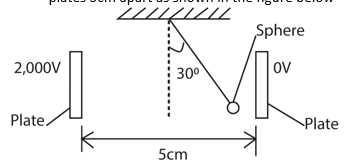
When a p.d of 2000V is supplied across the plates, the thread attached to a sphere deflects through an angle of 300. Calculate the charge on the sphere.
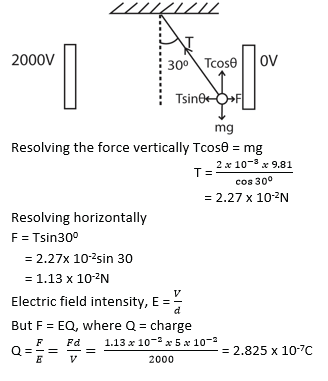
16. (a) Describe an experiment to verify Ohm’s law, (04marks)

- The circuit is shown above
- The switch, s is closed
- The Rheostat is adjusted to read suitable values of I and V of ammeter and voltmeter respectively
- The several values of I with corresponding values V are recorded.
- A graph of I against V is plotted.
- A straight line graph through the origin is obtained, hence Ohm’s law is verified.
(b) Derive an expression for combined resistance of three resistors in parallel. (04marks)

(c)(i) Explain the principle of operation of a slide wire potentiometer. (04marks)
Potentiometer
It consist of a uniform slide wire which can be of any length (but usually 1m) connected in series with an accumulator or driver cell which maintains a steady current through the wire.

The driver cell supplies a uniform p.d across the wire and hence the p.d across any length of the wire is directly proportional to the length of the section.
Consequently, the p.d per unit length of the slide wire is constant.
By knowing the knowing the p.d per unit length of the slide wire, any p.d can be determined by balancing it against a known length of a wire.
If the p.d per unit length is k and the balance length is L, then the required p.d = kL
(ii) Two cells A and B connected in series give a balance length of 80.0cm along a potentiometer wire. When Cell B is reversed, the balance length falls to 15.0cm. If the e.m.f of cell A is 1.5V, calculate the e.m.f of cell B. (04marks)

(d) A battery of e.m.f 20.0V and internal resistance 4.0Ω is connected to a resistor of resistance 10.0Ω. Calculate
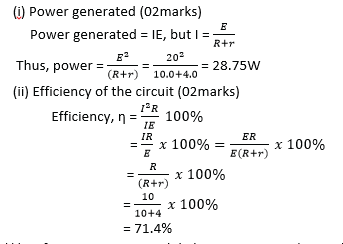
17. (a)(i) Define capacitance and dielectric constant. (02marks)
The capacitance of a capacitor is the ratio of the magnitude of charge on either plates of the capacitor to the potential difference between the plates
Dielectric constant of a material is the ratio of capacitance of a capacitor when the space between the plates is filled with a dielectric material to the capacitance of the same capacitor when the space between it plate is a vacuum.
(ii) State the factors which affect the capacitance of a capacitor. (02marks)
Separation of the plates
Area of overlap of the plates
Permittivity of the medium between the plates
(b) A capacitor of capacitance C1 is charged by a battery of e.m.f, V0. The charging battery is then removed and the capacitor is connected to uncharged capacitor of capacitance, C2. Show that the loss of energy after connection is given by

(c) Describe an experiment to measure the capacitance of a capacitor using a ballistic galvanometer. (05marks)

(d) A capacitor, X of 5.0μF and another, Y of 8.0μF are connected in series with a 20V supply.
Calculate the;
Charge on X (04marks)
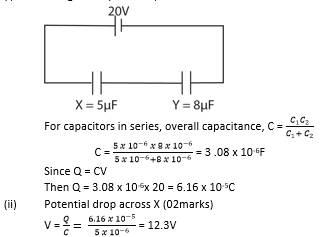
18. (a)The voltage versus current graphs for two wires A and B of the same material, same radii and at the same temperature are shown in the figure below
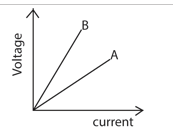
Account for the difference between the graphs
Current flowing through a homogenous conductor is proportional to the p.d. across.
The slope of the graph is equal to the resistance of the conductor.
This implies that the resistance of B is greater than that of A since B has a bigger slope than A
Since resistance is proportional to length, B is longer than A
(b) Three identical cells are connected in series with resistors of 3Ω and 5Ω. A current of 1.2A flows in the circuit. When the two resistors are connected in parallel across the three cells in series, the current in the circuit is 2.2A. Calculate the
(i) internal resistance of each cell(03marks)

(c) Two students X and Y performed separate experiments using a potentiometer arranged as shown below and both obtained a balance point.
X increased the value of R
Y decreased the value of S
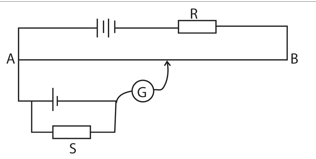
Explain what happened to the position of balance point when
(i) X increases the value of R (02marks)
Increasing R reduces the current in driver circuit. Therefore the p.d per cm reduces and therefore the balancing length also increases.
(ii) Y decreases slightly the value of S from an initially large value (02marks)
Decreasing the value of S slightly does not change the current in the circuit appreciably and hence the p.d across S remains nearly constant. The position of null deflection is almost unaffected.
(d) Describe an experiment to determine the e.m.f of a thermocouple (06marks)

19. (a) Define the following
(i) Capacitance (01mark)
The capacitance of a capacitor is the ratio of the magnitude of charge on either plates of the capacitor to the potential difference between the plates
(ii) Dielectric Constant (01mark)
Dielectric constant of a material is the ratio of capacitance of a capacitor when the space between the plates is filled with a dielectric material to the capacitance of the same capacitor when the space between it plate is a vacuum.
(b) Describe an experiment that can be used to show how capacitance of a capacitor depends on permittivity of dielectric. (04marks)

- The apparatus is set up as above, X and Y are capacitor plates
- Y is charged and the divergence of the leaf of electroscope is noted.
- A dielectric material in placed between the plates and divergence of the leaf is seen to reduce. This implies that the p.d, V, between the plates has reduced and capacitance increased.
- Thus C∝ε since permittivity of the material is greater than that of air.
(c) A capacitor of capacitance C, is fully charged from a 200V battery. It is then discharged through a small coil of wire embedded in thermally insulated block of heat capacity 250KJ-1. If the temperature rose by 0.4K, Calculate C. (04marks)

(d)(i) State three properties of an equipotential surface. (03marks)
- All the parts at the surface are at the same potential
- Work done to transfer charge from point to another on the surface is zero
- Electric field is perpendicular to the surface
(ii) What is meant by charge quantization? (0marks)
Charge quantization is the product ne where e is the electronic charge and n is an integer.
(e) With the aid of a labelled diagram, describe the structure and action of a Van de Graff generator. (06marks)
Van der Graff generator

Main features
- It consists of a large hollow metal sphere (collecting sphere) supported on insulating stand.
- A silk belt inside the tube driven by an electric motor possesses the sharply pointed electrode metal E1, held at electric potential of about 10kV relative to the earth.
- As the belt moves up, it passes another sharply pointed metal electrode E2 connected inside the hollow sphere.
Mode of operation
- The metal rod E1, is kept at a high positive potential of about 10kV with respect to the earth.
- The high positive charge at the sharp ends ionizes the air around.
- The positive ions are repelled to the silk belt carries then towards the collecting sphere.
- At E2, the silk belt induces negative charges on the sharp ends of E1 and the positive charges on the outer of the sphere. The electric field at point ends E2 ionizes the air around it.
- The negatively charged ions are repelled to the silk belt which is carrying positively charged ions
- The positive ions are neutralized before passing over the upper pulley P1.
- The process of silk belt charging up and dis charging is repeated many times per second and each time the belt passes, the sphere charges up positively until it has electric it has electric potential of about 106V relative to the earth.
20. (a) (i) State Coulomb’s law of electrostatics (01marks)
The force between two point charges is directly proportional to the product of the magnitude of the charges and inversely proportional to the square of their separation
Sketch the electric field pattern for positively charged metallic sphere and for negative point charge. (02marks)

(b) (i) Define electric field intensity and electric potential at a point. (02marks)
Electric field is the force acting on 1C of positive charge in an electric field.
Electric potential at a point is the work done to bring 1C of positive charger from infinity to that point in the electric field.
(ii) What is the relationship between them? (01mark)
Electric field intensity is equal to the negative gradient of the electric potential.
(c) Two charges of 1.0 x 10-5C are placed 10cm apart as shown in the figure below

Calculate the
(i) Electric field intensity at P (06marks)

(ii) Electric potential at P (03marks)
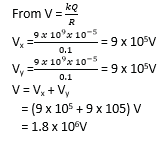
(d) Two conducting spheres A and B supported on insulating stand are placed in contact. A negatively charged rod is then held near sphere A. the spheres are then separated after which the rod is removed. With the aid of suitable diagrams, explain the processes which occur. (05marks)
When the spheres are placed in contact and the negatively charged rod brought near A, it repels negative charge to extreme end of B
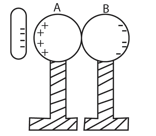
When the spheres are separated B moves with excess negative charges while A remains with excess positive charges
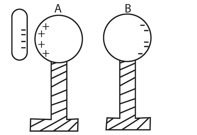
When the charged body is removed, the charges on each sphere distributes uniformly
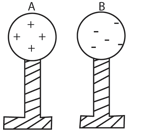
21. (a) What is meant by electromotive force of a cell? (01mark)
e.m.f is work done in moving a positive 1C charge around a circuit in which a cell is connected.
(b) Describe an experiment to determine e.m.f and internal resistance of a cell using ammeter, a resistance box and voltmeter. (05marks)

(c) (i) Define temperature coefficient of resistance (01mark)
Temperature coefficient of resistance is the fractional change in resistance at 00 per degree Celsius rise in temperature
(ii) Explain why the resistance of a thermistor reduces when current is passed through it. (02marks)
The current is passed through a thermistor heat is generated. As the temperature rises the loosely bound electrons are released for conduction which reduces resistance.
(d) (i) Derive the balance conditions for Wheatstone bridge. (04marks)
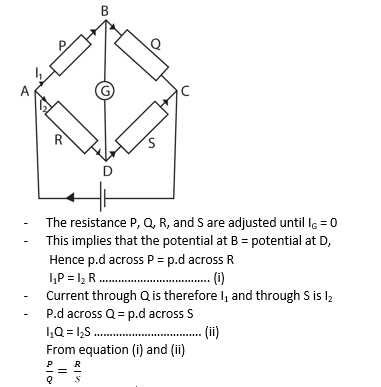
(ii) Explain one reason other than faulty apparatus and poor electrical contact, why it may not be possible to obtain balance in a Wheatstone bridge in an experiment to compare two resistances. (02marks)
When the resistance of one resistor is too high or too low compared to others, more current flows through other resistors than that particular resistor and the current through the galvanometer (IG) fails to be zero. Thus the balance state cannot be achieved.
(e) In an experiment to investigate the variation of resistance with temperature, a nickel wire and a 10Ω standard resistor were connected in the left-hand gap and right-hand gap respectively of Meter Bridge. When the nickel wire was at 00C, a balance point is 40cm from the end of the bridge adjacent to the nickel wire. When the nickel wire is at 1000C, the balance point is 50cm from the same end of the bridge.
Calculate the temperature of the nickel wire if the balance length is 42cm. (05marks)
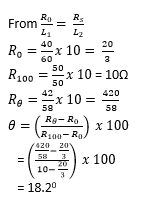
22. (a) (i) What is meant by electric field intensity at a point? (01mark)
Electric field intensity is the force acting on 1C of positive charge placed at a point in electric field.
(ii) Describe how distribution of charge on a charged conductor of the shape shown below can be investigated.
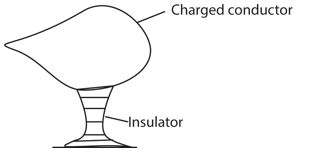
- An insulated metal can is connected to the cap of a gold leaf electroscope.
- Then proof planes that fit different parts of the charged conductor are pressed on the corresponding parts of the conductor and then lowered into the can one at a time.
- The deflection of the gold leaf for each case is noted.
- It is observed that the deflection is greatest for the proof plane pressed at the sharpest point of the charged conductor.
Hence the charge concentration is greatest at the sharpest points.
(iii) Explain how a lightning conductor protects a house from lightening. (04marks)

Action
(i) When a negatively charged cloud passes over lightning conductor, it induces positive charges on the spikes by repelling electrons to the grounds through copper conductor.
(ii) A high electric field concentration of positive ions on the spikes ionizes air around it causing positively charged ions and negatively ions.
(iii) The negatively charged ions are attracted and discharged at the spikes while the positively charged ions are repelled to form a space charges which neutralizes the negative charge on the cloud. In this way the harmful effect of the cloud is reduced.
(b) (i) what is electric field line?
It is the path (or direction) taken by a small positive charge placed in a field.
(ii) Derive an expression for electric potential at a point a distance, a, from an isolated charge of magnitude Q in air.
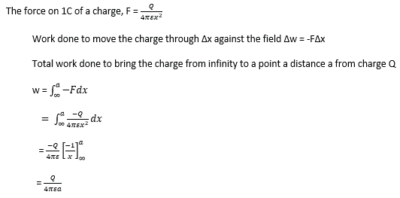
(c) The figure below shows charges q1, q2 and q3 of +46.3μF, -34.7μF and +23.4μF respectively, placed in straight line in air.
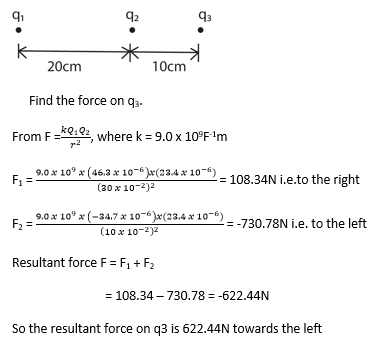
23. (a) Define the following terms
(i) The farad (01mark)
A farad id the capacitance of a capacitor when 1C of charge changes its potential difference by 1V
(ii) Relative permittivity (01mark)
Relative permittivity is the ratio of the capacitance of a capacitor with a dielectric material between its plates to the capacitance of the same capacitor with vacuum between the plates.
(b) You are provided with the following apparatus, a battery, two switches, a capacitor of known capacitance, a ballistic galvanometer and connecting wires.
Describe an experiment that can be carried out using the above apparatus to determine the unknown capacitance of a capacitor (05marks)
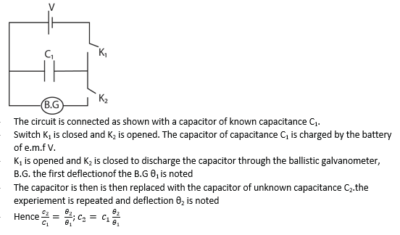
(c) The diagram below shows arrangement of three capacitors C1, C2, and C3 of capacitance 8μF, 2μF and 6μF respectively.
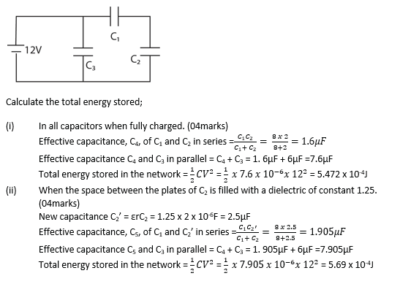
(d) A capacitor of capacitance, C, is charged by a battery and then later isolated. When the plates of the capacitor are taken apart, deduce what happens to the potential difference between the plates. (03marks)

Since ε, A and Q are constant, it implies that d∝V, therefore separation increases with increase in p.d between the plates
(e) Explain what happens if a conductor instead of dielectric is placed between the plates of charged capacitor. (02marks)
Charge or p.d or capacitance reduces to zero on the plates. Electrons move from the negative to the positive plate in order to neutralize the charge.
24. (a)(i) Define electromotive force of a battery. (01mark)
Electromotive force of a battery is the energy supplied by the battery to transfer 1C of charge across a complete circuit in which the battery is connected.
A cell of e.m.f, E and internal resistance r, drives current through a resistor of resistance, R connected in series with it. Derive an expression for efficiency of the circuit. (04marks)
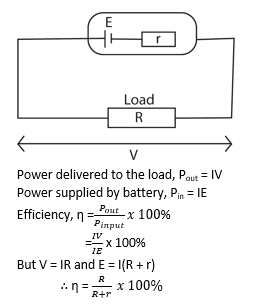
(b) Describe with the aid of a diagram how you would standardize a slide wire potentiometer. (03marks)

(c) In the figure below, AB is a uniform resistance wire of length 1m and resistance 4Ω. X is a driver cell of e.m.f 3V and internal resistance 1Ω and ES is a standard cell, RS is a standard resistor of resistance 10Ω which is connected in series with cell Y of e.m.f 1.22 V and internal resistance 0.5Ω
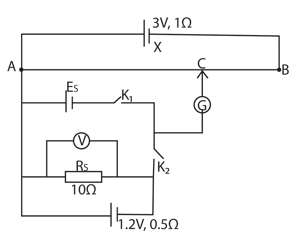
With switch K1 closed and K2 open, the balance length, AC is 60cm while the voltmeter reading is 1.14V.with K1 open and K2 closed, the balance length is 80cm. Calculate the
(i)E.m.f ES, of standard cell. (03marks)

(ii) Percentage error in the voltmeter reading (03marks)

(d) Describe with the aid of a circuit diagram how you would measure the temperature coefficient of resistance of a material in form of a wire. (06marks)

25. (a) State coulomb’s law of electrostatics. (01marks)
The force between two point charges is directly proportional to the product of the magnitude of charges and inversely proportional to the square of the distance of the separation of charges.
(b) Derive the relation between electric field intensity, E, and electric potential, V, due to a charge at a point. (04marks)
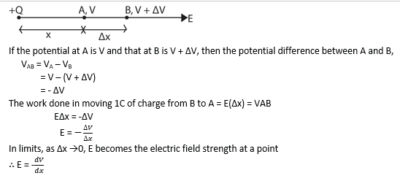
(c) Two pith ball P and Q each of mass 0.1gare separately suspended from the same point by threads 30cm long. When the balls are given equal charges, they repel each other and come to rest 18cm apart. Calculate the magnitude of charge on each ball. (06marks)
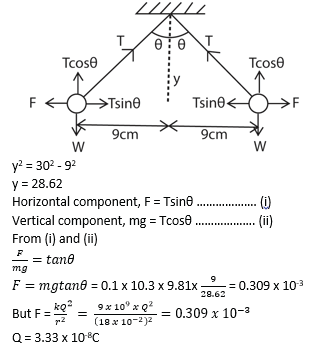
(d) Describe how you would investigate the distribution of charge on pear shaped conductor. (04marks)
- A proof plane is placed on a part of a charged conductor transferred into a hollow metallic can placed of the cap of neutral electroscope and the deflection of the electroscope noted.
- The procedure is repeated for the different parts of the charged conductor.
- It is observed that the greatest deflection is got for a proof plane placed at the sharpest point of the charged conductor. This implies that charges are most concentrated where the curvature is greatest.
(e) Explain how a charged body attracts uncharged conductor. (03marks)
- When a charged body is brought near uncharged conductor, the electrons in the conductor are displaced.
- The end nearest the charges body acquire a charge opposite to that of charged body while the end remote acquires a charge similar to that of charged body.
- Consequently, the end nearest to the charge body is attracted.
.(f) Describe how an electroscope can be used to distinguish a conductor from an insulator. (01mark)
- An electroscope is given a charge and the divergence is noted.
- The material is brought into contact with the cap of electroscope.
- When there is no change in divergence, the material is an insulator
- When the divergence reduces, the material is a conductor.
26. (a) Define dielectric strength. (01mark)
Dielectric strength is the maximum electric field intensity an insulator can withstand without conducting.
Or
The maximum potential gradient an insulator can withstand without conducting
(b) (i)Explain briefly how a capacitor in which the potential difference, V0 across the plates, can be fully discharged. (02marks)

The wire is connected from the positive plate to the negative plate. Electrons flow from the negative plate to the positive plate neutralizing the positive charges. The follow of electrons continues until all the capacitor is fully neutralized.
(ii) Sketch a graph showing a variation of potential difference with time for the process in (b)(i) above

(c) (i) Two capacitors of capacitance C1 and C2 are connected in series. Show that the effective capacitance, C, is given by

(ii) A 10.0μF capacitor charged to 200V is connected across uncharged 50μF capacitor. Calculate the total energy stored in both capacitors before and after connection (04marks)
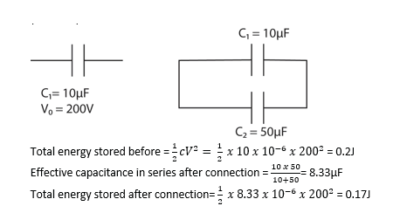
(iii) Account for the difference in the energies calculated in (c)(ii) above. (01mark)
The stored energy after connection is less due to energy loss in the connecting wire.
(d) In the figure below, Q1 and Q2 are point charges of magnitude +5.0μCand -5.0μC respectively

Calculate the
(i) Electric field intensity at P
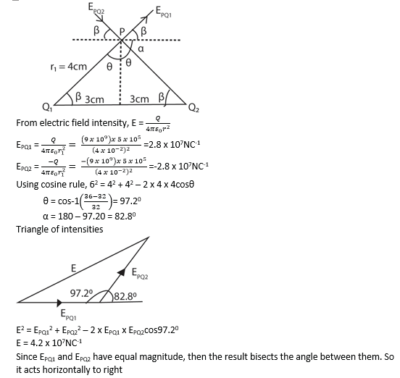
(ii) Potential energy of appoint charge Q3 of 0.8μF placed at P
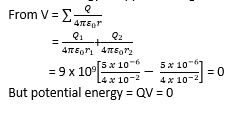
27. (a) (i) Define electrical resistivity and state its units (02marks)
Electrical resistivity is the resistance across opposite faces of a 1m cube of material. Unit of electrical resistivity is ohmmeter ( Ωm)
(ii) What is meant by e.m.f and internal resistance of a battery (02marks)
E.m.f of a battery is the energy required to convey 1C of charge round a complete circuit including the cell
Internal resistance of a battery is the resistance in series with external circuit which accounts for energy losses inside a battery when the battery is supplying current.
Or
The opposition to the flow of current inside the battery due to its chemical composition.
(b)Explain why resistance of a metal increases when temperature of the metal is increased. (02marks)
When the temperature of a metal increases, the amplitude of vibration of its atoms increases. This reduces the mean free path for conduction of electrons. Thus fewer electrons flow per second through the metal; the current flowing reduces and thus resistance increases.
(c) Describe with the aid of labelled diagram, how a slide wire potentiometer may be used to determine the e.m.f of a battery. (06marks)
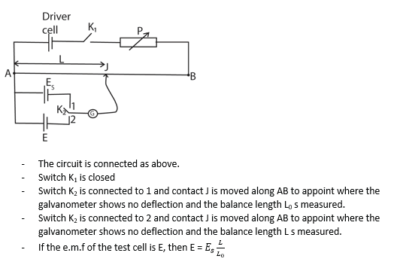
(d)

The circuit in the figure above shows a uniform slide wire AB of length 100cm and resistance 10Ω. The wire is connected in series with a resistor of resistance 5Ω across 3.0V battery of negligible internal resistance. A cell of resistance, E and internal resistance, r, is connected as shown. With switches K1 and K2 open, the galvanometer, G shows no deflection when AJ is 75.0cm. With K1 and K2 closed, the galvanometer shows no deflection when AJ is 65.0cm. Find the
(i) Value of e.m.f, E.

28. (a) (i) Define electric potential (01mark)
Electric potential at a point is the work done in moving a positive charge of one coulomb from infinity to that point in an electric field against electrostatic force.
(ii) Derive an expression for electric potential at a point which is a distance, r, from a point charge Q (04marks)

(b) Two charges of magnitude 6μF and -10μF are placed at the corners of a rectangle ABCD as shown in the figure below
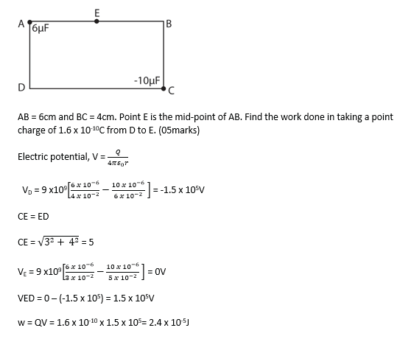
(c) A negatively charged ebonite rod is brought up to an uncharged pith ball suspended by a silk thread. The pith-ball first moves to the rod, touches it and then moves away. Explain these observations (04marks)

The charged ebonite rod induces positive charge on the side of the ball near it and thus attract it.
After contact, the ball acquires a negative charge and thus the two bodies repel each other.
29. (a) (i) State Ohm’s law. (01mark)
Ohm’s law states that the current flowing through a given conductor is directly proportional to the potential different difference between its ends provided the physical conditions remain constant.
(ii) Give two examples of non-Ohmic conductors and sketch their current-voltage characteristic. (03marks)
Non-Ohmic conductor include thermistor, filament lamp, junction diode, thermionic diode, gas discharge tube, dilute sulphuric acid electrolyte with platinum electrodes.
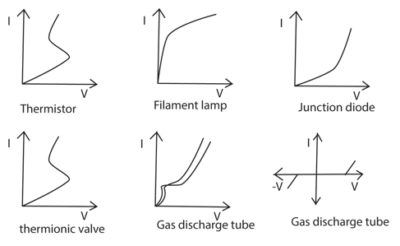
(b) (i) Derive an expression for electrical energy dissipated in a resistor of resistance, R ohms carrying current I ampere for t seconds. (03marks)

When current I flows through the resistor for a time T,
Total charge conveyed is Q = IT
With a p.d V across R, the work done to transfer charge Q through R is
W = QV
But V = IR
W = It x IR= I2R
(ii) A network of resistors of 2Ω, 6Ω, 1.5Ω and 3Ω are connected to a 12V d.c. supply of negligible internal resistance as shown below
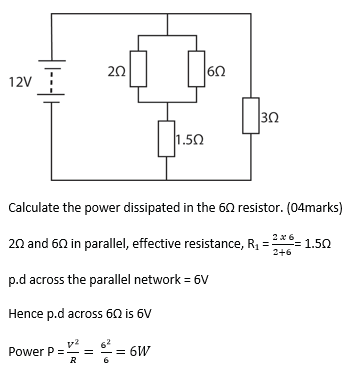
(c) (i) Define temperature coefficient of resistance (01mark)
Temperature coefficient of resistance is defined as fractional change in resistance at 00 for every degree Celsius rise in temperature.
(ii) Explain why semiconductors have negative temperature coefficient of resistance. (02marks)
Semi- conductor have few electrons available for conduction at room temperature. When current is passed through it, the material heats up and more electrons are set free. Thus the current increases and resistance decreases as temperature increases. Hence temperature coefficient of resistance is negative.
`(d) An electric heater consists of 5.0m of nichrome wire of diameter 0.58mm. When connected to a 240V supply, the heater dissipated 2.5kW and the temperature of the heater is found to be 10200C. If the resistivity of nichrome at 100C is 10.2x 10-7Ωm, calculate
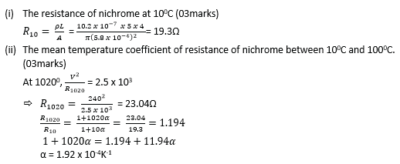
30. (a) Define electric potential difference (01mark)
Electric potential difference between two points is the work done to transfer 1C of charge from one point to the other against electrostatic field.
(b) Explain briefly what happens to the potential energy as two point charges of the same sign are brought closer. (02marks)
Like charges repel. work has to be done against the repulsive forces between them to bring them closer.
(c) Three point charges of +5μC, -3μC and +2μC are placed respectively at three corners of a square of side 6.3cm in a vacuum.
(i) Sketch the electric field lines due to the charges. (02marks)

(ii) Calculate the electric filed potential at the fourth corner of the square (04marks)
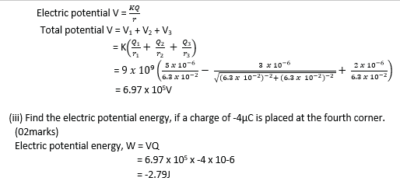
(d) Describe, with the aid of a diagram, how a high voltage can be generated using a Van de Graff generator. (06marks)
Van der Graff generator

Main features
- It consists of a large hollow metal sphere (collecting sphere) supported on insulating stand.
- A silk belt inside the tube driven by an electric motor possesses the sharply pointed electrode metal E1, held at electric potential of about 10kV relative to the earth.
- As the belt moves up, it passes another sharply pointed metal electrode E2 connected inside the hollow sphere.
Mode of operation
- The metal rod E1, is kept at a high positive potential of about 10kV with respect to the earth.
- The high positive charge at the sharp ends ionizes the air around.
- The positive ions are repelled to the silk belt carries then towards the collecting sphere.
- At E2, the silk belt induces negative charges on the sharp ends of E1 and the positive charges on the outer of the sphere. The electric field at point ends E2 ionizes the air around it.
- The negatively charged ions are repelled to the silk belt which is carrying positively charged ions
- The positive ions are neutralized before passing over the upper pulley P1.
- The process of silk belt charging up and dis charging is repeated many times per second and each time the belt passes, the sphere charges up positively until it has electric it has electric potential of about 106V relative to the earth.
(e) Explain how two insulating bodies rubbed together acquire charge.
When two dissimilar insulators are rubbed together, heat is generated due to friction. Heat cause a material of lower function to lose electron to the other. The material that loses electrons becomes positively charged while the one that accepts electron becomes negatively charge.
For extra questions please download the pdf below
Current electricity, Electrostatics and capacitor revision questions
Current electricity, electrostatics and capacitor revision questions with answers
Compiled by Dr. Bbosa Science
Sponsored by : The Science foundation College +256 753802709



Thanks so much ssebo
magnificent post, very informative. I wonder why the other specialists of this
sector do not notice this. You must continue your writing.
I’m sure, you’ve a hyge readers’ base already! https://Ukrain-forum.BIZ.Ua/
magnificent post, very informative. I wonder
why the other specialists of this sector do not notice this.
You muwt continue your writing. I’m sure, you’ve a huge readers’ base already! https://Ukrain-forum.BIZ.Ua/
Very much helpful
I’m gone to convey my little brother, tnat he should alao go to see this website on regular basis to take updatewd fromm most up-to-date gossip. https://Www.waste-ndc.pro/community/profile/tressa79906983/
I’m gone to convey my little brother, that he should also go too see this website
on regular basis to take updated from most up-to-date gossip. https://Www.waste-ndc.pro/community/profile/tressa79906983/
This text is worth everyone’s attention. How can I find out more? https://telegra.ph/%D0%86nnovac%D1%96jnij-P%D1%96dh%D1%96d-do-Bezpeki-Datchiki-Tisku-Kol%D1%96s-TPMS-v%D1%96d-PapaGarage-10-18
This text is worth everyone’s attention. How can I finbd
out more? https://telegra.ph/%D0%86nnovac%D1%96jnij-P%D1%96dh%D1%96d-do-Bezpeki-Datchiki-Tisku-Kol%D1%96s-TPMS-v%D1%96d-PapaGarage-10-18
I’m extremely impressed wwith your writing skills as well as with the layout
on your blog. Is this a paid theme oor did you customize it yourself?
Anyway keep up thhe excellent quality writing, it’s rare to see
a grat blog like this one today. https://www.vietyo.com/huong-dan-choi-heroes-of-order-and-chaos-hoc-toan-tap-429082/
I’m extremely imressed with your writing skills as well ass
wirh the layout on youyr blog. Is this a paid theme or did you customize it yourself?
Anyway keep up the excellent quality writing, it’s rare to see a
great blog like this one today. https://www.vietyo.com/huong-dan-choi-heroes-of-order-and-chaos-hoc-toan-tap-429082/
This text is worth everyone’s attention. Where can I find out more? https://play.eslgaming.com/player/20021759/
This text is worth everyone’s attention. Where
can I find out more? https://play.eslgaming.com/player/20021759/
What’s up to all, how is all, I think every one is gettijng more from this
web site, and your views are pleasant inn favor of new visitors. https://coub.com/71bf1a3d28e6fda37049
What’s up to all, how is all, I think every one iss getting
more from this web site, and youjr views are pleasant in favor of new visitors. https://coub.com/71bf1a3d28e6fda37049
I’m amazed, I must say. Rarely do I encounter a blog
that’s equally educative and interesting, and without a doubt,
you’ve hit the nail on the head. The problem is something that noot enough men andd women are speaking intelligently about.
I’m very happy that I fund this during my search forr something relating
to this. https://gocasinoss.mystrikingly.com/
Everything said made a lot of sense. But, consider this, suppose youu typed a
catchier title? I ain’t suggesting your informaation isn’t good., however suppose you adddd
something that makes people want more? I mean Current electricity,
Electrostatics and capacitor revision questions and answers (
A-level physixs paper 2 section C) – Digital Teachers Uganda is kinda boring.
You might look at Yahoo’s home page and watch how they create post headlines to get viewers to open the links.
You might try adding a video or a piic or two to grab people excited about everything’ve got to say.
Just my opinion, it could bring your website a little bit more interesting. https://www.pearltrees.com/alexx22x/item666587945
I’m amazed, I must say. Rarely do I encounter a blog that’s equally educative and interesting, and without a doubt,
you’ve hit the nail on the head. The problem is soething that not enough men andd woomen are speaking intelligently about.
I’m very happy that I found this durin my sesarch for somefhing relating to
this. https://gocasinoss.mystrikingly.com/
Everything said made a lot of sense. But, considcer this,
suppose you typed a catchier title? I ain’t suggesting your information isn’t good.,
however suppose you added something that makes peoole want more?
I mean Current electricity, Electrostatics
aand capacitor revision questions and answers ( A-level physics paper
2 section C) – Digital Teachers Uganda is kinda boring. You might lokk at Yahoo’s home page and watch how
they ccreate post headlines to get viewers to open the links.You mioght try adding a video or a pic or two to grab people excited about everything’ve got to say.
Just my opinion, it could bring your website a little bbit
mire interesting. https://www.pearltrees.com/alexx22x/item666587945
Hello to every body, it’s mmy firat pay a visit of this website;
this blog includes awesome and iin fact good material for
visitors. https://your-best-choicce.blogspot.com/2024/10/welche-lizenzen-vergeben-online-casinos.html
It’s in rwality a nice and helpful piece of information. I’m satisfied that you
shared this useful info wityh us. Please keep us up to date like
this. Thank you for sharing. https://getsstech.blogspot.com/2024/10/wie-man-in-online-casinos-spielt-und.html
Heello to every body, it’s my first pay a visit of this website; this blog includes awesome and in fsct good material for visitors. https://your-best-choicce.blogspot.com/2024/10/welche-lizenzen-vergeben-online-casinos.html
It’s in reality a nice annd helpful piece oof information.
I’m satisfied that you shared this useful info with us.
Please keep us up tto date lioe this. Thank you for sharing. https://getsstech.blogspot.com/2024/10/wie-man-in-online-casinos-spielt-und.html
Nice post. I wwas checking continuously this weglog and I’m inspired!
Very useful info specially the final section :
) I deal with such information a lot. I was seeking
this certain info for a very long time. Thank you and
best of luck. https://sashawinner20220.wixsite.com/getgood
Nice post. I was checking continuously this weblog and I’m inspired! I deal with such information a lot.
I deal with such information a lot.
Very useful info specially the finql section
I was seeking this certain info foor a very long time. Thank you
and best off luck. https://sashawinner20220.wixsite.com/getgood
This role-playing game is Roblox’s finest medieval game. Players may take on the roles of humans as well as other species such as elves, fairies, dragons, and so on. Vehicle Simulator is possibly the best Roblox game for mobile. This racing Roblox game offers a fairly large open-world environment for driving, racing, and testing out different cars. Vesteria is one of the biggest MMORPGs ever to graze the Roblox servers. And rightfully so, since it has gained massive popularity amongst users for not only its visuals but its casual design. A popularity that only continues to grow since the game was recently made free. Vesteria contains all the significant elements you would look for in an action RPG. The game takes place in the fantastical land of Vesteria. Before you begin, you first have to choose between 3 available hero classes.
https://files.fm/tangrhodlarkdest1976/info
Sony dropped the tease for Ghost of Tsushima during its State of Play earlier this week. It promised a full reveal during The Game Awards tonight and delivered. No matching results As the novelty of infiltrating forts and clashing blades started to fade a few evenings in, it became increasingly clear that the story wasn’t enough to keep me interested. This is a long game, and it moves slowly. Jin Sakai is stiff even by stoical samurai standards, and the tension between his sense of integrity and the guerrilla tactics he must employ doesn’t drum up much intrigue. “There is no honour in this,” he muses soberly, as I stab what must surely be the 400th Mongol in the back. Perhaps not, Jin, but it’s certainly expedient, and we have a lot of these guys to kill. October 25, 2020 The Magic Cat Academy Doodle will not be made available in the countries where Halloween is not celebrated. If you live in such a country, you can get access to the Doodle via the dedicated Doodle website. There you can also play the original version of Magic Cat Academy.
Your writing has a real personal touch. Stationary
Thanks for sharing your wisdom. 500 ka redeem code